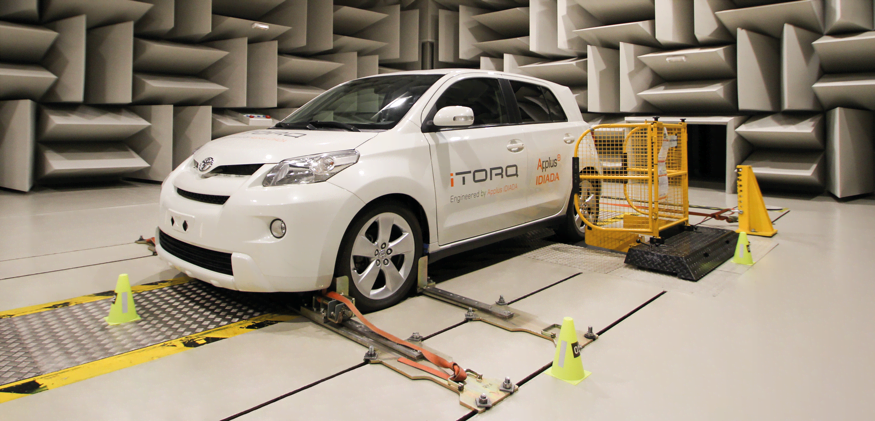When electric vehicles (EVs) first appeared on the market around ten years ago, acoustic engineer Xavier Montané thought he would soon be out of a job. “It’s funny to remember that many of us young acoustic engineers thought that if the car was to become silent, our whole mission and purpose was over! But the reality has proven just the opposite: a new range of noises that were previously masked by combustion engines have become more prominent. There is still plenty for us to do and I think our jobs are secure,” Xavier smiles.
Xavier is NVH Testing Coordinator at Applus+ IDIADA. He and his colleagues work with all types of vehicles, from passenger cars and motorbikes to commercial vehicles. “I remember when we tested the first EV, we were surprised at how loud the road noise was. We experienced the sound differently before because it was masked by the engine. Now it was much more invasive.”

The Science of Human Perception
In NVH, human perception is very important as people experience sounds differently. Some people prefer low-frequency sounds and some prefer high-frequency sounds. This even varies across cultures. “For example, Europeans are more bothered by high-frequency sounds and the Japanese find low-frequency noises a bit irritating,” Xavier explains.
NVH - NOISE, VIBRATION, AND HARSHNESS
A big part of the job when doing NVH subject assessments for OEMs is understanding these cultural and market characteristics and how to apply them to the vehicle evaluation. This is a skill that only comes with experience. “We have tools that can assist this process,” says Xavier, “but ultimately, the microphone can’t measure human perception. Only we humans can.”
Preparing for the Future
Xavier began working on Applus+ IDIADA 15 years ago, fresh from university. After initially studying Telecommunication (audiovisual systems), he changed his focus to acoustics. “I had always been interested in math and physics and I discovered that acoustics were more firmly based in science than cinema or television. So, I decided to become an acoustic engineer.” As EVs and hybrid electric vehicles (HEVs) continue their rise in the market, and as cities continue to grow and focus on mitigating noise pollution, the world needs acoustic engineers now more than ever.
Although EVs require no combustion engine, no fuel tank, no air intake or exhaust systems, no long drive shafts or centre bearings, there are other noise sources taking their place. Electric motor noise, road and tyre noise, wind noise and ancillary system noise to name a few. As EVs and HEVs become more ubiquitous, these are the noise sources Xavier and his team will be focusing on in the future.
Electric Motor Noise
“Even though they are quieter than internal combustion (IC) engines, it would be wrong to assume that electric motors are completely quiet,” says Xavier. These motors generate high-frequency tonal noises that can be quite annoying. The noises originate from the different components of the engine, such as the inverter and DC/DC converter. “Although electric motors present a lesser challenge than IC engines, it still requires a major effort to develop strategies for mechanical and acoustic isolation of the motor. We have a lot of people working on this right now.”
Road and Tyre Noise
Most of an EV’s life is spent operating between 25 and 50 miles per hour. At this speed, wind noise is still minimal and motor noise is mostly masked by road and tyre noise. That means that the most dominant noise experienced by drivers and passengers of EVs will mostly be road and tyre noise.
“Changes on weight distribution, mixing heavy battery packs and lighter weight vehicle structures make it difficult to mitigate road and tyre noise,” says Xavier. “We try to confront this with a focus on tire technology, mechanical isolation in the suspension and innovative noise control materials in the interior and exterior of the car. And, of course, we must do this without adding weight and cost to the vehicle.”
The quality of roads is an issue that cities and governments are working to solve. “Tyre companies are working to improve tyres, but if the roads aren’t good enough, they will not be able to achieve any major improvements. As a part of noise pollution control, cities will need to find a better material for road surfaces that can absorb the noise caused by the impact of the tyre on the road.”
Protecting Pedestrians
“When you first cross the street, the first thing you use is your ears. As all vehicles become quieter, the lack of exterior noise poses a danger to pedestrians.” Governments are becoming increasingly focused on this. Over the past few years, Applus+ IDIADA has participated, along with a few OEMs, in a project led by the European Commission. The goal was to get a better understanding of which exterior sounds EVs could generate to signal to pedestrians that vehicles are approaching.
“We tried to design a vehicle that detects pedestrians and sends a focused sound in the direction of the pedestrian to alert them.” This work by the EC will likely lead to the development of regulations that will define the sound that OEMs and car manufacturers must use in their vehicles. When this regulation is imposed, Xavier and his team will be ready to help their clients produce the correct sound.
Ancillary System Noise
Without an engine to drive the air conditioning and heating, the windows and other mechanical systems, a whole range of electric ancillary devices will be needed to provide these functionalities. Each of these devices bring with them vibration and acoustic challenges that individually are relatively minor, but as a whole could become significant.
“Most of these sounds will become background noise if the vehicle is on the motorway, but when it’s stationary or moving at lower speeds, these buzzing and whirring sounds could become annoying. In future, it will become an even higher priority for OEMs to reduce the noise of these ancillary components.”
Next-generation Drivers
Looking to the future, Xavier ponders what the preferences of the next generation of drivers will be. “When today’s drivers make the transition from IC to electric engine, they tend to miss the sounds that give them the feeling of being in a car – the feeling of motion and control,” he explains. OEMs are creating fake noises that compensate for this.
“I’m wondering if the new generation of drivers will continue to enjoy these sounds or if perhaps they will become redundant or even annoying to them. Maybe instead, they will want to customize their internal sounds with funny or novel noises. Or maybe they will prefer no noises at all – just as quiet a ride as possible.” Only time will tell what preference future drivers will have for their car sounds, but in any case, Xavier and Applus+ IDIADA will be ready to deliver.
Testing an iTORQ Toyota Urban Cruiser 4WD with four individual inboard electric motors (one per wheel), modified by IDIADA. The iTORQ system is a motion-control module that distributes drive torque between the wheels depending on driver input and road conditions.
LEARN MORE
Applus+ IDIADA's vehicle engineering services
RELATED ARTICLES

当社ニュースレターを購読すると音とバイブレーションの世界からの最新情報を取得できます。


